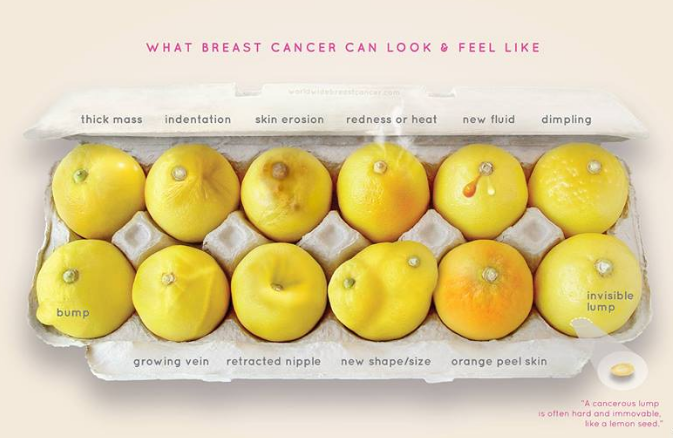Breast cancer indicators explained through lemons
“Without having seen a picture randomly with real information, I wouldn’t have know what to look for,” Ms Chieze wrote.

Your support helps us to tell the story
From reproductive rights to climate change to Big Tech, The Independent is on the ground when the story is developing. Whether it's investigating the financials of Elon Musk's pro-Trump PAC or producing our latest documentary, 'The A Word', which shines a light on the American women fighting for reproductive rights, we know how important it is to parse out the facts from the messaging.
At such a critical moment in US history, we need reporters on the ground. Your donation allows us to keep sending journalists to speak to both sides of the story.
The Independent is trusted by Americans across the entire political spectrum. And unlike many other quality news outlets, we choose not to lock Americans out of our reporting and analysis with paywalls. We believe quality journalism should be available to everyone, paid for by those who can afford it.
Your support makes all the difference.The confusion over what to look and feel for when routinely checking breasts for signs of cancer is not unfamiliar. But a new campaign has recruited an unlikely ally to boost breast cancer awareness: the lemon.
The image, designed in 2003 by Corrine Beaumont, founder of the Worldwide Breast Cancer, visually describes breast cancer signs for the ‘Know Your Lemons’ campaign that is gaining traction on social media.
The lemon metaphors present a clear visual way of showing breast cancer signifiers, helping with the difficulties of self-checking.
Twelve lemon images alert people to less well-known symptoms, such as a change in the shape of the breast or dimpling on the skin.
While the advice to check for lumps is common knowledge, other indicators can often go undetected. Signs such as thick mass, new fluid and indentations in the breast are shown by the viral campaign, which has since been translated into 16 different languages.
“Some patients don’t want to talk about breasts or look at them. Often women used in campaigns don’t look like ordinary women – but even those with little literacy can understand this,” Ms Beaumont told the BBC.
She added that the egg box of lemons presents a playful, friendly image that might help women overcome their fear of breast cancer.
Cancer survivor Erin Smith Chieze, shared the photograph on Facebook to promote the campaign and her post has since been shared more than 45,000 times.
“Without having seen a picture randomly with real information, I wouldn't have know what to look for.”
Ms Chieze said she saw an indentation that looked similar to one of the pictures and then booked an appointment in which she was diagnosed with stage four breast cancer.
“I knew what breast cancer was. I knew all about self exams. But a picture of what to look for keyed me into knowing I had a terminal disease. We need to give REAL information," she explained.
Ms Chieze wrote: “If you truly want to help people WITH cancer, or those who will GET cancer, share photos like this one.”
“I am SO thankful that other women and men may see this and know what they are possibly looking at and seek immediate medical attention,” she added.
According to the BBC, a survey of 1,000 women by charity Breast Cancer Care found that a third of women fail to check their breasts regularly for signs of cancer, with more than a quarter not knowing that an inverted nipple can be a symptom.
Professor Jayant Vaidya, professor of surgery and oncology at University College London, told the BBC that indentation or flattening of the breast, especially when the arm is lifted or when women lean forward, is also an important early sign.
Professor Vaidya said that growing veins and inflammation are more rare symptoms and that orange peel skin and large bumps are advanced signs.
"Showing lemons in an egg box seems to draw interest and attention to the issue and people may remember the signs better,” he told the BBC.
“But women will usually find the new 'invisible' lump in their breasts; it is the most common and frequently the only symptom," he added.
Join our commenting forum
Join thought-provoking conversations, follow other Independent readers and see their replies
Comments